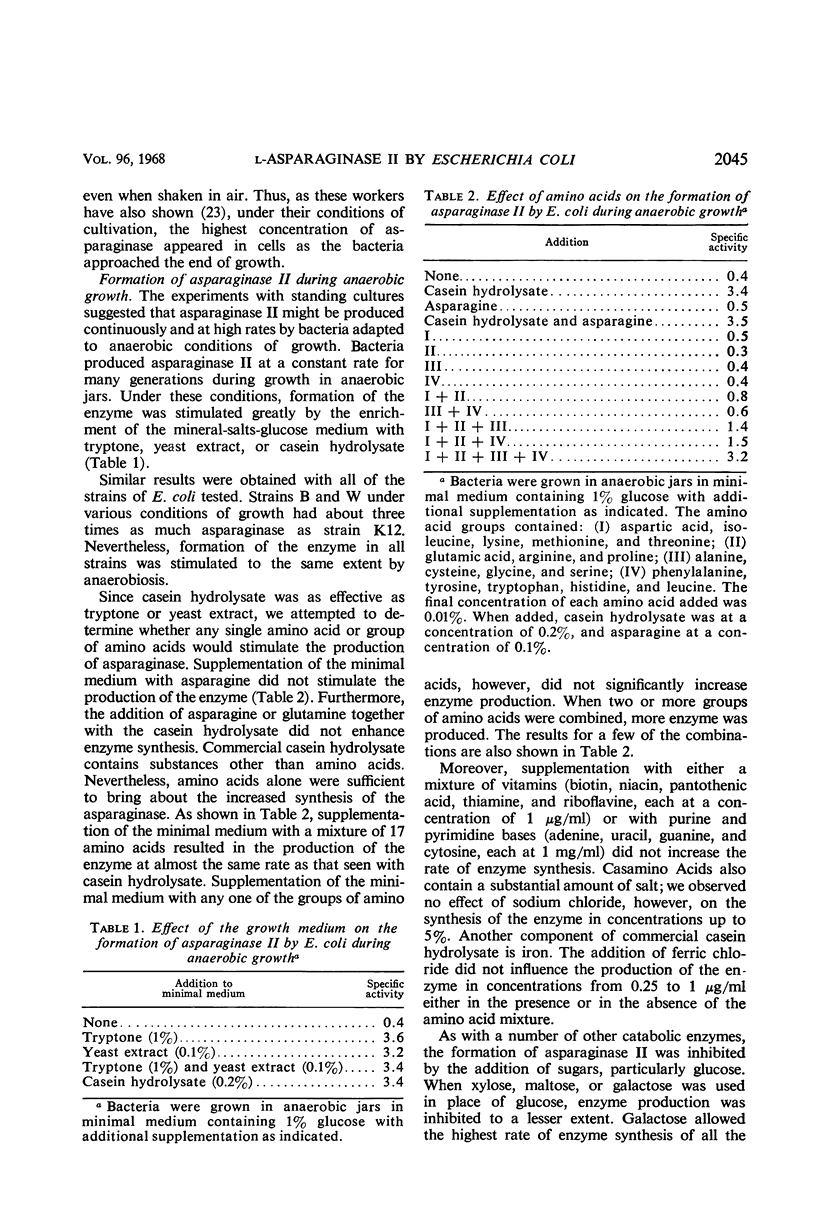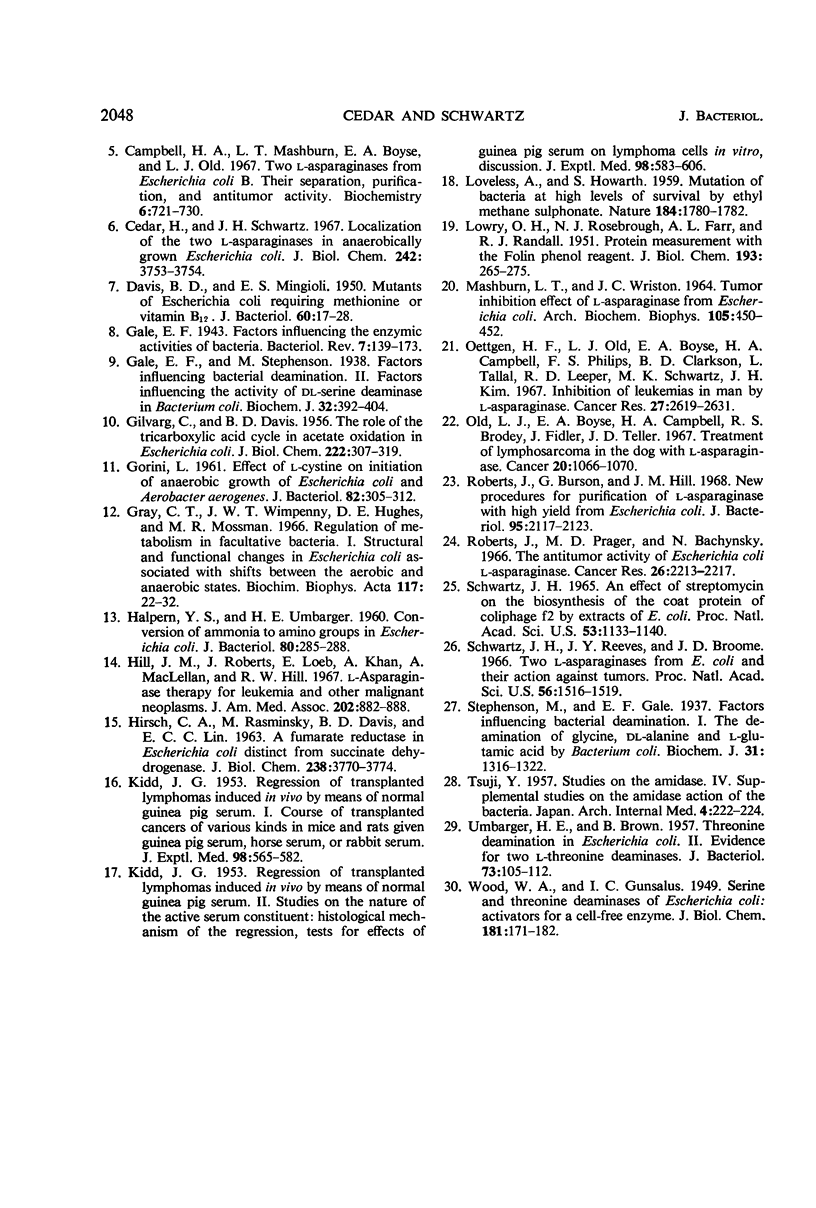Abstract
l-Asparaginase II was synthesized at constant rates by Escherichia coli under anaerobic conditions. The enzyme was produced optimally by bacteria grown between pH 7 and 8 at 37 C. Although some enzyme was formed aerobically, between 100 and 1,000 times more asparaginase II was produced during anaerobic growth in media enriched with high concentrations of a variety of amino acids. Bacteria grown under these conditions should provide a rich starting material for the large-scale production of the enzyme. No single amino acid specifically induced the synthesis of the asparaginase, nor did l-asparagine, even when it was used as the only source of nitrogen. The enzyme was produced at lower rates in the presence of sugars; glucose was the most inhibitory.
Full text
PDF





Selected References
These references are in PubMed. This may not be the complete list of references from this article.
- Amarasingham C. R., Davis B. D. Regulation of alpha-ketoglutarate dehydrogenase formation in Escherichia coli. J Biol Chem. 1965 Sep;240(9):3664–3668. [PubMed] [Google Scholar]
- BROOME J. D. Evidence that the L-asparaginase of guinea pig serum is responsible for its antilymphoma effects. I. Properties of the L-asparaginase of guinea pig serum in relation to those of the antilymphoma substance. J Exp Med. 1963 Jul;118:99–120. doi: 10.1084/jem.118.1.99. [DOI] [PMC free article] [PubMed] [Google Scholar]
- Campbell H. A., Mashburn L. T., Boyse E. A., Old L. J. Two L-asparaginases from Escherichia coli B. Their separation, purification, and antitumor activity. Biochemistry. 1967 Mar;6(3):721–730. doi: 10.1021/bi00855a011. [DOI] [PubMed] [Google Scholar]
- Cedar H., Schwartz J. H. Localization of the two-L-asparaginases in anaerobically grown Escherichia coli. J Biol Chem. 1967 Aug 25;242(16):3753–3755. [PubMed] [Google Scholar]
- DAVIS B. D., GILVARG C. The role of the tricarboxylic acid cycle in acetate oxidation in Escherichia coli. J Biol Chem. 1956 Sep;222(1):307–319. [PubMed] [Google Scholar]
- DAVIS B. D., MINGIOLI E. S. Mutants of Escherichia coli requiring methionine or vitamin B12. J Bacteriol. 1950 Jul;60(1):17–28. doi: 10.1128/jb.60.1.17-28.1950. [DOI] [PMC free article] [PubMed] [Google Scholar]
- GORINI L. Effect of L-cystine on initiation of anaerobic growth of Escherichia coli and Aerobacter aerogenes. J Bacteriol. 1961 Aug;82:305–312. doi: 10.1128/jb.82.2.305-312.1961. [DOI] [PMC free article] [PubMed] [Google Scholar]
- Gale E. F. FACTORS INFLUENCING THE ENZYMIC ACTIVITIES OF BACTERIA. Bacteriol Rev. 1943 Sep;7(3):139–173. doi: 10.1128/br.7.3.139-173.1943. [DOI] [PMC free article] [PubMed] [Google Scholar]
- Gale E. F., Stephenson M. Factors influencing bacterial deamination: Factors influencing the activity of dl-serine deaminase in Bacterium coli. Biochem J. 1938 Feb;32(2):392–404. doi: 10.1042/bj0320392. [DOI] [PMC free article] [PubMed] [Google Scholar]
- Gray C. T., Wimpenny J. W., Hughes D. E., Mossman M. R. Regulation of metabolism in facultative bacteria. I. Structural and functional changes in Escherichia coli associated with shifts between the aerobic and anaerobic states. Biochim Biophys Acta. 1966 Mar 28;117(1):22–32. doi: 10.1016/0304-4165(66)90148-6. [DOI] [PubMed] [Google Scholar]
- HALPERN Y. S., UMBARGER H. E. Conversion of ammonia to amino groups in Escherichia coli. J Bacteriol. 1960 Sep;80:285–288. doi: 10.1128/jb.80.3.285-288.1960. [DOI] [PMC free article] [PubMed] [Google Scholar]
- HIRSCH C. A., RASMINSKY M., DAVIS B. D., LIN E. C. A FUMARATE REDUCTASE IN ESCHERICHIA COLI DISTINCT FROM SUCCINATE DEHYDROGENASE. J Biol Chem. 1963 Nov;238:3770–3774. [PubMed] [Google Scholar]
- Hill J. M., Roberts J., Loeb E., Khan A., MacLellan A., Hill R. W. L-asparaginase therapy for leukemia and other malignant neoplasms. Remission in human leukemia. JAMA. 1967 Nov 27;202(9):882–888. [PubMed] [Google Scholar]
- KIDD J. G. Regression of transplanted lymphomas induced in vivo by means of normal guinea pig serum. I. Course of transplanted cancers of various kinds in mice and rats given guinea pig serum, horse serum, or rabbit serum. J Exp Med. 1953 Dec;98(6):565–582. doi: 10.1084/jem.98.6.565. [DOI] [PMC free article] [PubMed] [Google Scholar]
- KIDD J. G. Regression of transplanted lymphomas induced in vivo by means of normal guinea pig serum. II. Studies on the nature of the active serum constituent: histological mechanism of the regression: tests for effects of guinea pig serum on lymphoma cells in vitro: discussion. J Exp Med. 1953 Dec;98(6):583–606. doi: 10.1084/jem.98.6.583. [DOI] [PMC free article] [PubMed] [Google Scholar]
- LOVELESS A., HOWARTH S. Mutation of bacteria at high levels of survival by ethyl methane sulphonate. Nature. 1959 Dec 5;184:1780–1782. doi: 10.1038/1841780a0. [DOI] [PubMed] [Google Scholar]
- LOWRY O. H., ROSEBROUGH N. J., FARR A. L., RANDALL R. J. Protein measurement with the Folin phenol reagent. J Biol Chem. 1951 Nov;193(1):265–275. [PubMed] [Google Scholar]
- MASHBURN L. T., WRISTON J. C., Jr TUMOR INHIBITORY EFFECT OF L-ASPARAGINASE FROM ESCHERICHIA COLI. Arch Biochem Biophys. 1964 May;105:450–452. doi: 10.1016/0003-9861(64)90032-3. [DOI] [PubMed] [Google Scholar]
- Oettgen H. F., Old L. J., Boyse E. A., Campbell H. A., Philips F. S., Clarkson B. D., Tallal L., Leeper R. D., Schwartz M. K., Kim J. H. Inhibition of leukemias in man by L-asparaginase. Cancer Res. 1967 Dec;27(12):2619–2631. [PubMed] [Google Scholar]
- Old L. J., Boyse E. A., Campbell H. A., Brodey R. S., Fidler J., Teller J. D. Treatment of lymphosarcoma in the dog with L-asparaginase. Cancer. 1967 Jul;20(7):1066–1070. doi: 10.1002/1097-0142(196707)20:7<1066::aid-cncr2820200709>3.0.co;2-m. [DOI] [PubMed] [Google Scholar]
- Roberts J., Burson G., Hill J. M. New procedures for purification of L-asparaginase with high yield from Escherichia coli. J Bacteriol. 1968 Jun;95(6):2117–2123. doi: 10.1128/jb.95.6.2117-2123.1968. [DOI] [PMC free article] [PubMed] [Google Scholar]
- Roberts J., Prager M. D., Bachynsky N. The antitumor activity of Escherichia coli L-asparaginase. Cancer Res. 1966 Oct;26(10):2213–2217. [PubMed] [Google Scholar]
- Schwartz J. H. An effect of streptomycin on the biosynthesis of the coat protein of coliphage f2 by extract of E. coli. Proc Natl Acad Sci U S A. 1965 May;53(5):1133–1140. doi: 10.1073/pnas.53.5.1133. [DOI] [PMC free article] [PubMed] [Google Scholar]
- Schwartz J. H., Reeves J. Y., Broome J. D. Two L-asparaginases from E. coli and their action against tumors. Proc Natl Acad Sci U S A. 1966 Nov;56(5):1516–1519. doi: 10.1073/pnas.56.5.1516. [DOI] [PMC free article] [PubMed] [Google Scholar]
- Stephenson M., Gale E. F. Factors influencing bacterial deamination: The deamination of glycine, dl-alanine and l-glutamic acid by Bacterium coli. Biochem J. 1937 Aug;31(8):1316–1322.1. doi: 10.1042/bj0311316. [DOI] [PMC free article] [PubMed] [Google Scholar]
- UMBARGER H. E., BROWN B. Threonine deamination in Escherichia coli. II. Evidence for two L-threonine deaminases. J Bacteriol. 1957 Jan;73(1):105–112. doi: 10.1128/jb.73.1.105-112.1957. [DOI] [PMC free article] [PubMed] [Google Scholar]
- WOOD W. A., GUNSALUS I. C. Serine and threonine desaminaes of Escherichia coli; activators for a cell-free enzyme. J Biol Chem. 1949 Nov;181(1):171–182. [PubMed] [Google Scholar]


